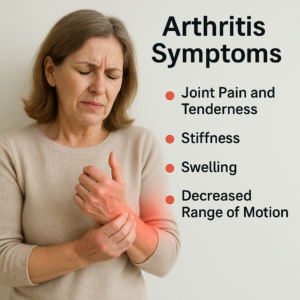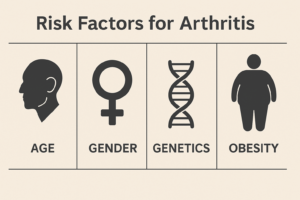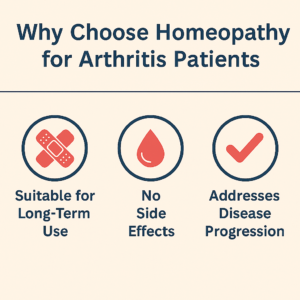Understanding Arthritis: Signs And Homeopathic Treatment
Arthritis is a common yet often misunderstood condition that affects millions of people around the world. If you’re dealing with joint pain, stiffness, or inflammation, you might be wondering whether arthritis is the culprit. In this article, we’ll explore what arthritis is, the different types, symptoms to look out for, and treatment options available to help manage this chronic condition.
What is Arthritis?
Arthritis is not a single disease. In fact, it’s a term used to describe more than 100 different types of joint disorders. The most common forms are osteoarthritis (OA) and rheumatoid arthritis (RA). While both affect the joints, they do so in different ways.
-
Osteoarthritis is a degenerative joint disease caused by wear and tear.
-
Rheumatoid arthritis is an autoimmune condition where the immune system attacks the joints.
Common Symptoms of Arthritis

The symptoms of arthritis vary depending on the type, but there are several common signs to watch for:
-
Joint pain and tenderness
-
Stiffness, especially in the morning or after rest
-
Swelling around joints
-
Decreased range of motion
-
Redness or warmth in affected areas
If you experience any of these symptoms regularly, it’s important to consult a healthcare provider for a proper diagnosis.
Causes and Risk Factors

There isn’t a single cause of arthritis. However, several risk factors can increase your chances of developing the condition:
-
Age: Risk increases with age
-
Gender: Women are more likely to develop rheumatoid arthritis
-
Genetics: Family history plays a role
-
Obesity: Extra weight puts added stress on joints
-
Injuries: Previous joint injuries can lead to arthritis later in life
Understanding these risk factors can help with early detection and prevention.
Diagnosis: How is Arthritis Detected?
To diagnose arthritis, doctors typically start with a physical exam. They may also use:
-
X-rays and MRI scans to assess joint damage
-
Blood tests to detect inflammation markers
-
Joint fluid analysis to rule out infections or other causes
Early diagnosis is essential, as it allows for more effective treatment and prevents further joint damage.
Treatment Options
Although there is no cure for arthritis, many treatment options can help manage the symptoms:
1. Medications
-
Nonsteroidal anti-inflammatory drugs (NSAIDs) reduce inflammation and pain.
-
Corticosteroids help control severe symptoms.
-
Disease-modifying antirheumatic drugs (DMARDs) are used for autoimmune forms like RA.
2. Physical Therapy
Exercise and movement are key to maintaining joint function. Physical therapists can guide you through safe and effective exercises.
3. Lifestyle Changes
-
Weight management reduces stress on joints.
-
Balanced diets rich in anti-inflammatory foods can help manage symptoms.
-
Low-impact exercises like swimming or yoga keep joints flexible without strain.
4. Surgery
In severe cases, joint replacement surgery might be necessary. This is often recommended when other treatments have failed and daily activities are significantly affected.
Living Well With Arthritis
Despite the challenges arthritis presents, many people lead full, active lives by taking proactive steps to manage their condition. First and foremost, staying informed about your type of arthritis is crucial. Furthermore, building a support system—whether it’s through family, friends, or online communities—can make a big difference in your mental and emotional well-being.
Final Thoughts
Arthritis may be a lifelong condition, but with the right treatment plan and lifestyle adjustments, it can be effectively managed. Early detection, proper medical care, and a proactive attitude are your best tools in fighting joint pain and maintaining a high quality of life.
If you suspect you may have arthritis, don’t wait—consult a healthcare provider today. The sooner you take action, the better your outcomes will be.
Why Homeopathy Is the Best Choice for Arthritis Patients

Arthritis is a chronic condition that affects millions of people worldwide, causing joint pain, stiffness, and reduced mobility. While conventional treatments offer temporary relief, many patients are now exploring alternative therapies—with homeopathy being a standout choice. Here’s why homeopathy is increasingly recognized as the best choice for managing arthritis naturally and effectively.
1. Individualized and Holistic Treatment
Unlike one-size-fits-all approaches, homeopathy treats each patient as a unique individual. It takes into account not just the physical symptoms, but also the emotional and psychological aspects of the patient. This personalized care ensures more targeted and effective results.
For example, two arthritis patients with similar joint pain may receive entirely different remedies, depending on their overall constitution and health history.
2. Safe for Long-Term Use
Arthritis is often a long-term condition, requiring consistent treatment. Homeopathic remedies are non-toxic, non-habit forming, and safe for prolonged use. They do not lead to side effects or dependency, which is especially important for elderly patients or those with multiple health conditions.
3. Addresses the Root Cause, Not Just Symptoms
One of the key strengths of homeopathy is that it works at the root level. Instead of merely suppressing symptoms like pain or swelling, it stimulates the body’s natural healing mechanism. Over time, this leads to a more balanced immune response and less frequent flare-ups.
4. Minimal to No Side Effects
Unlike conventional drugs such as NSAIDs or steroids, which often come with a host of side effects, homeopathic remedies are prepared using high dilutions of natural substances. As a result, they are incredibly gentle on the body—even for sensitive individuals.
5. Improves Quality of Life
Homeopathic treatment not only reduces pain and inflammation but also helps patients regain mobility, flexibility, and better emotional well-being. This holistic improvement contributes to a significantly enhanced quality of life.
6. Cost-Effective and Easily Accessible
Another significant advantage is that homeopathic remedies are often more affordable than conventional medications. Moreover, they are available globally and can be taken without the need for invasive procedures or high medical costs.
Here are 5 commonly used homeopathic medicines for arthritis, each with its indications and key uses:
🧴 1. Rhus Toxicodendron (Rhus Tox)
Best for: Arthritis with stiffness, especially after rest
Key symptoms:
-
Pain and stiffness improve with movement
-
Worse in cold, damp weather
-
Feels better with warm applications or baths
🧴 2. Bryonia Alba
Best for: Arthritis with intense pain aggravated by movement
Key symptoms:
-
Pain worsens with slightest motion
-
Joints feel hot, swollen, and stiff
-
The patient prefers to lie still and avoid movement
🧴 3. Ledum Palustre
Best for: Arthritis that starts in lower limbs and moves upward
Key symptoms:
-
Cold application relieves pain (opposite of most cases)
-
Swollen, painful joints
-
Often used for gout or arthritis after injury
🧴 4. Calcarea Carbonica
Best for: Arthritis in overweight or chilly individuals
Key symptoms:
-
Joint stiffness worse from exertion or climbing stairs
-
Profuse sweating (especially head and feet)
-
Craving for eggs and indigestible things like chalk
🧴 5. Causticum
Best for: Arthritis with muscle weakness and deformities
Key symptoms:
-
Joint deformities due to chronic rheumatic conditions
-
Pain worse in cold, dry weather
-
Better with warmth and continued movement
⚠️ Note: These remedies should be used under the guidance of a qualified homeopath. Proper selection depends on the total symptom picture of the individual.
Final Thoughts
While there is no one-size-fits-all solution to arthritis, homeopathy offers a safe, natural, and effective path to long-term relief. Its focus on holistic healing, minimal side effects, and personalized care makes it a top choice for those seeking gentle yet powerful alternatives.
If you’re struggling with arthritis and want a sustainable, side-effect-free approach, consider consulting a qualified homeopath today.
More Usefull Links:
